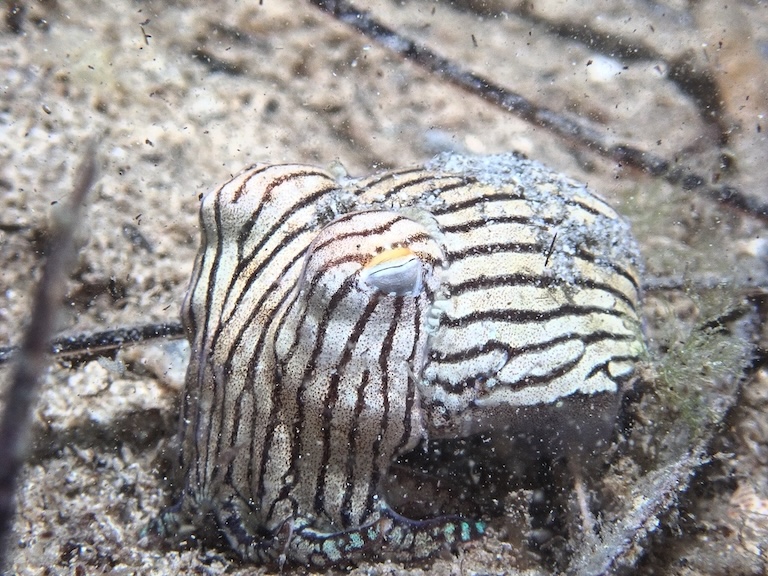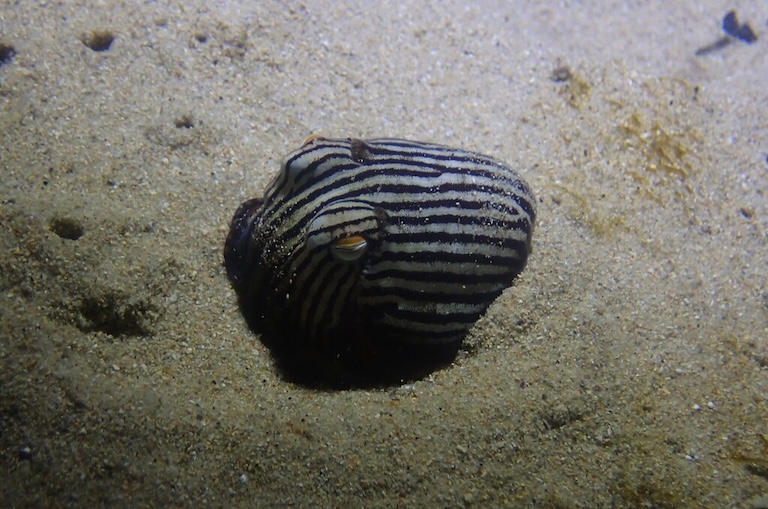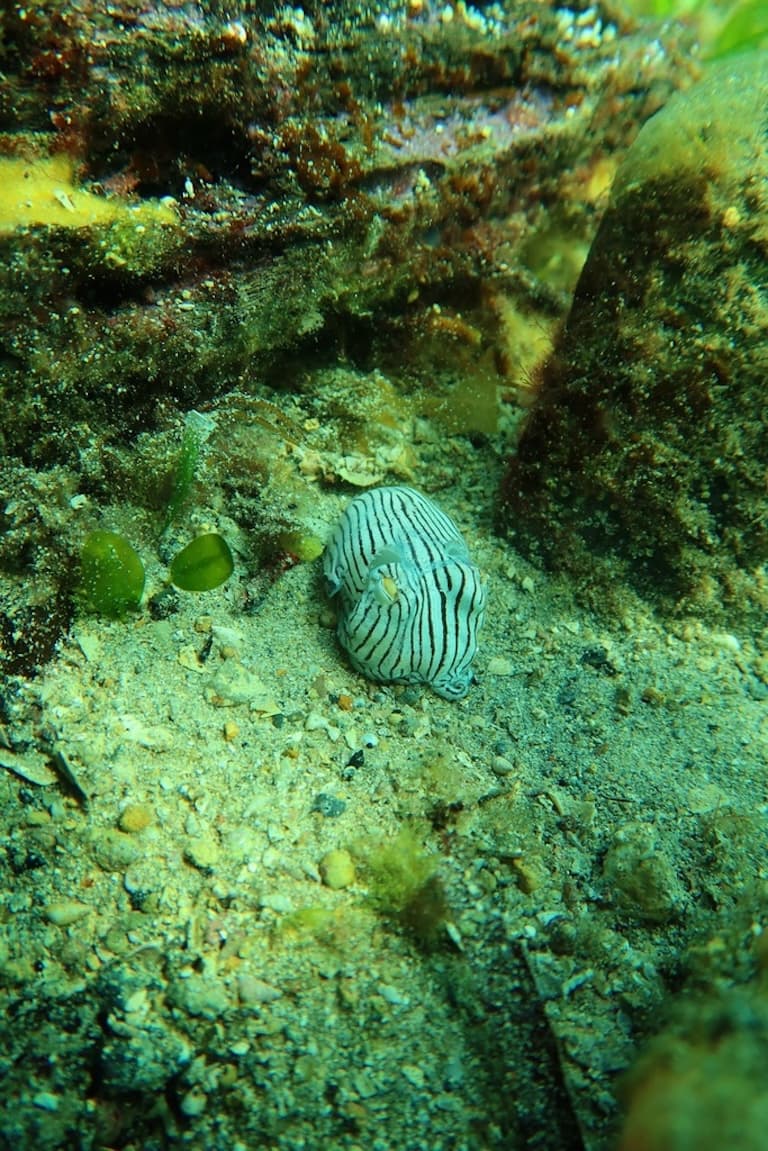Striped Pyjama Squid Profile
Instinctively, it’s easy to reject the notion of a mollusc being adorable, but some of them really put this baseless absolutism to the test.
If you’re not swayed by the cute little eye stalks of the conches, check out the cephalopods: cuttlefish, in particular, with their wide-eyed curiosity and endearing intellect, are very hard to ignore, and when they’re the size of a thumbnail and wearing pyjamas, you’ve got no hope at all.

Striped Pyjama Squid Facts Overview
| Habitat: | Sandy marine sediments near seagrass beds |
| Location: | South, east and west Australia in shallow coastal waters |
| Lifespan: | Unknown |
| Size: | Up to 8 cm (3 in) |
| Weight: | Not listed |
| Colour: | White with black stripes |
| Diet: | Fish, shrimp and crustaceans |
| Predators: | Few, but some larger fish, cephalopods, crustaceans |
| Top Speed: | Slow |
| No. of Species: | 1 |
| Conservation Status: | Data Deficient |
This tiny cephalopod has plenty of defensive capabilities to compensate for its diminutive size. First off, it uses a pseudonym: the stripped pyjama squid is actually a cuttlefish.
If that doesn’t throw enemies off the scent, it also provides poisonous slime, venomous bites and an ink screen to disappear behind.
But the most well-known defence in cuttlefish is also perhaps its least understood. Colour changing in these animals is more than just about camouflage, it’s how they talk to one another, and using colours we can’t see and angles of light we don’t understand, they are surely hiding something…
Interesting Striped Pyjama Squid Facts
1. They’re not squid
These tiny tentacled molluscs are one of eight species in their family and only two in the genus.
This genus, Sepioloidea, is collectively known as the bobtail, bottletail, or pyjama squids, but they’re not squid at all, but cuttlefish – a suborder of 120 cephalopod species that diverged from their squid relatives around 150 million years ago.
The pyjama part is a little more accurate, as this small cuttlefish has a distinctly striped pattern. Its rounded shape is said to resemble a dumpling, earning it the nickname “striped dumpling squid”, but this is pushing it a bit.
It’s mostly found around the Great Barrier Reef and extends around central South Australia. Being tiny and brightly coloured might sound like a disadvantage in the notoriously shark-infested waters of coastal Australia, but this little ‘pod has some tricks up its mantle. 1

2. They have highly enriched slime
Much like the school cafeteria, the pyjama squid provides hungry urchins with a mouthful of enriched goop. But this isn’t fortified with vitamin B12, it’s thick with toxins instead.
This whole family of cuttlefish is known for its defensive slime, which acts well on its own as a slippery deterrent, but also as a poisonous one, containing over 28 proteins, some of which are peptidases, or enzymes designed to break down proteins.
It’s inferred from this that the pyjama squid isn’t a tasty snack but a toxic one, and if the poison doesn’t turn you off, how about venom? 2
3. They’re venomous
While poisons are toxins that function through ingestion or skin contact, venoms are toxins that are injected, and Coleoid cephalopods (octopuses, cuttlefishes, and squids) often employ venom for predation or defence.
This is typically delivered through a bite or drilled hole using their parrot-like beak and toothed radula, which is essentially a scraping tongue.
Despite their potential, the study of cephalopod toxins has been limited to a small number of species, and not all that much is known about the qualities and diversity of venoms in this order, but they are very promising avenues of discovery for the newly emerging field of venom research.
Even, or perhaps especially, a small cuttlefish like this has venom, and while its danger to humans doesn’t seem to be all that high, it’s said to contain tetrodotoxin, which is a highly potent neurotoxin found in pufferfish and other dangerous marine animals.
But this is one of the last lines of defence, as the cephalopods rely on camouflage perhaps more than any other known animal.
4. They change colour
This species spends most of its time hidden in the sand, but when it does have to emerge, it opens and closes cells in its skin called chromatophores which cover and uncover colour pigments and make the animal change colour to blend into its environment.
Colour change is great as a camouflage but in cuttlefish in particular, it’s also used as a way of communicating which is so alien to humans that researchers are only just starting to realise it exists. 3
5. They can see polarised light
We have pretty good vision for an animal, but we’re limited in a number of ways. We have three opsins, which allow us to perceive any combination of reds, blues and greens, but some animals have four, and some species of cuttlefish have as many as six.
There is no way to imagine or simulate what this would look like, any more than you can simulate the sixth dimension with only three to do it in.
This is an inconceivable improvement on the dimensions with which the cephalopod eye has to work, and it doesn’t end at colour, they can also see the angle of polarised light.
Light gets a lot more whacky in the shallow ocean, and polarisation plays more of a role, so it makes sense that animals evolved to use it.
On top of the exponential amount of information, each additional opsin provides the cuttlefish, being able to understand polarised light adds another layer to their visual processing.

6. This is great for communication
Being able to see polarised light enhances contrast, which helps spot camouflaged predators hiding against their backgrounds, but it also can be used to convey information in place of colour, which creates the ability for highly complex communication systems between conspecifics.
Cuttlefish are woefully under-represented in the cephalopod-loving community, often overlooked for crowdpleasers like the giant squids and the blue-ringed octopuses. But they have a tremendous amount to teach us about alien communication
These signals are often used for communication, with species like cuttlefish relying on polarization patterns rather than colour to convey information, demonstrating the complexity and utility of this unique visual capability. 4
Striped Pyjama Squid Fact-File Summary
Scientific Classification
| Kingdom: | Animalia |
| Phylum: | Mollusca |
| Class: | Cephalopoda |
| Order: | Sepiida |
| Family: | Sepiadariidae |
| Genus: | Sepioloidea |
| Species: | lineolata |
Fact Sources & References
- Jaever Marcel (2021), “Two New ‘Bottletail Squids’ (Cephalopoda: Sepiadariidae) from New Zealand, with New Observations on Sepioloidea pacifica”, Open Repository.
- Nikeisha J. Caruana (2020), “Quantitative Proteomic Analysis of the Slime and Ventral Mantle Glands of the Striped Pyjama Squid (Sepioloidea lineolata)”, ACS Publications.
- “Striped Pyjama Squid”, IUCN Red List.
- (2020), “Polarisation in nature”, Optician.
